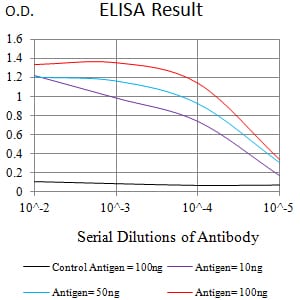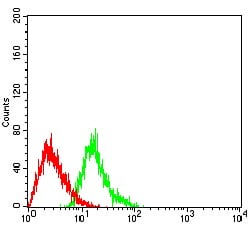

| WB | 咨询技术 | Human,Mouse,Rat |
| IF | 咨询技术 | Human,Mouse,Rat |
| IHC | 咨询技术 | Human,Mouse,Rat |
| ICC | 技术咨询 | Human,Mouse,Rat |
| FCM | 1/200 - 1/400 | Human,Mouse,Rat |
| Elisa | 1/10000 | Human,Mouse,Rat |
| Aliases | G9A; BAT8; GAT8; NG36; KMT1C; C6orf30 |
| Entrez GeneID | 10919 |
| clone | 6F3E5 |
| WB Predicted band size | 132.4kDa |
| Host/Isotype | Mouse IgG1 |
| Antibody Type | Primary antibody |
| Storage | Store at 4°C short term. Aliquot and store at -20°C long term. Avoid freeze/thaw cycles. |
| Species Reactivity | Human |
| Immunogen | Purified recombinant fragment of human EHMT2 (AA: 317-471) expressed in E. Coli. |
| Formulation | Purified antibody in PBS with 0.05% sodium azide |
+ +
以下是3篇关于EHMT2抗体的参考文献,简要总结如下:
---
1. **"G9a histone methyltransferase plays a dominant role in euchromatic histone H3 lysine 9 methylation and is essential for early embryogenesis"**
*作者*:Tachibana, M., Sugimoto, K., Fukushima, T., & Shinkai, Y. (2001)
*摘要*:该研究通过基因敲除和小鼠模型揭示了EHMT2(G9a)在调控H3K9甲基化中的核心作用,并开发了特异性抗体用于染色质免疫沉淀(ChIP)和免疫荧光实验,证实其在胚胎发育中不可或缺。
2. **"Structural context of disease-associated mutations in histone methyltransferase EHMT2"**
*作者*:Antonysamy, S., Bonday, Z., et al. (2013)
*摘要*:文章解析了EHMT2的晶体结构,并利用抗体进行蛋白质印迹(Western blot)和功能验证,揭示了疾病相关突变对其催化活性和底物结合的影响。
3. **"EHMT2 suppression upregulates retroelements and enhances anti-tumor immunity in lung adenocarcinoma"**
*作者*:Huang, X., Zhang, Y., et al. (2022)
*摘要*:研究使用EHMT2抗体评估其在肺腺癌中的表达,发现抑制EHMT2可激活内源性逆转录病毒并增强免疫应答,提示其作为癌症治疗靶点的潜力。
---
以上文献均涉及EHMT2抗体的实验应用,涵盖功能机制、结构解析及疾病关联研究。如需扩展或补充其他研究,可进一步检索近年文献数据库(如PubMed)。
The EHMT2 antibody targets the Euchromatic Histone Lysine Methyltransferase 2 (EHMT2), also known as G9a, a key enzyme in epigenetic regulation. EHMT2 catalyzes the mono- and dimethylation of histone H3 at lysine 9 (H3K9me1/me2), a modification associated with transcriptional repression. It primarily functions as part of a heterodimeric complex with EHMT1 (GLP), regulating gene silencing, chromatin compaction, and genomic imprinting. EHMT2 is critical in cellular processes like differentiation, embryonic development, and X-chromosome inactivation.
Dysregulation of EHMT2 is linked to diseases, including cancers (e.g., promoting tumor growth via silencing tumor suppressors), neurodevelopmental disorders (e.g., Kleefstra syndrome), and metabolic abnormalities. Its role in maintaining repressive chromatin marks makes it a potential therapeutic target.
EHMT2 antibodies are widely used in research to study protein expression, localization, and histone modification dynamics. Applications include Western blotting, immunohistochemistry, chromatin immunoprecipitation (ChIP), and immunofluorescence. Specificity validation is essential due to structural similarities among histone methyltransferases. These tools help elucidate EHMT2's functional mechanisms and its contribution to disease pathways, aiding drug development and epigenetic studies.
×